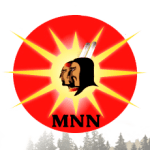MNN. JAN. 29, 2024. All North American museums depict lies and “genocide” of the onkwehonwe, the original people of turtle island. We want back everything that was taken from us such as the wampum records that were hidden or destroyed as if we never existed. Stop displaying our skulls for profit such as Apache Geronimo’s skull stolen and being filled with whiskey for the “Skull and Bones” ritual of the graduating elite at Yale University. We want all the museum buildings so we can display the truth of the evil practices that destroyed the people of the great peace to create the U.S.”Republic of War”.
Our “hanging tobacco” have been in the shadows doing their work. The truth must be shown such as the residential school death camps, the MKULTRA experiments by the CIA and Canada, the murders of our children whose remains are now being found. 120 million original people of the Western Hemisphere were murdered by the settler colonialists. The whole truth must be displayed! Grave robbing must end! Canada must step up to the plate immediately to enact a Graves Protection Act to help us find our people. Canada’s reaction to the mass graves found in 2021 was to create the Office of the Special Interlocutor for Missing Children. Their mandate will finish next summer. We need a permanent permanent independent onkwehonwe office for investigating the murders of our children. Although Canada has admitted genocide, there are no laws as in the US to protect our heritage?
Leading Museums Remove Native Displays Amid New Federal Rules
https://www.yahoo.com/news/leading-museums-remove-native-displays-183325697.html
NEW YORK — The American Museum of Natural History will close two major halls exhibiting Native American objects, its leaders said on Friday, in a dramatic response to new federal regulations that require museums to obtain consent from tribes before displaying or performing research on cultural items.
“The halls we are closing are artifacts of an era when museums such as ours did not respect the values, perspectives and indeed shared humanity of Indigenous peoples,” Sean Decatur, the museum’s president, wrote in a letter to the museum’s staff on Friday morning. “Actions that may feel sudden to some may seem long overdue to others.”
The museum is closing galleries dedicated to the Eastern Woodlands and the Great Plains this weekend, and covering a number of other display cases featuring Native American cultural items as it goes through its enormous collection to make sure it is in compliance with the new federal rules, which took effect this month.
Museums around the country have been covering up displays as curators scramble to determine whether they can be shown under the new regulations. The Field Museum in Chicago covered some display cases, the Peabody Museum of Archaeology and Ethnology at Harvard University said it would remove all funerary belongings from exhibition and the Cleveland Museum of Art has covered up some cases.
But the action by the American Museum of Natural History in New York, which draws 4.5 million visitors a year, making it one of the most visited museums in the world, sends a powerful message to the field. The museum’s anthropology department is one of the oldest and most prestigious in the United States, known for doing pioneering work under a long line of curators including Franz Boas and Margaret Mead. The closures will leave nearly 10,000 square feet of exhibition space off-limits to visitors; the museum said it could not provide an exact timeline for when the reconsidered exhibits would reopen.
“Some objects may never come back on display as a result of the consultation process,” Decatur said in an interview. “But we are looking to create smaller-scale programs throughout the museum that can explain what kind of process is underway.”
 The changes are the result of a concerted effort by the Biden administration to speed up the repatriation of Native American remains, funerary objects and other sacred items. The process started in 1990 with the passage of the Native American Graves Protection and Repatriation Act, or NAGPRA, which established protocols for museums and other institutions to return human remains, funerary objects and other holdings to tribes. But as those efforts have dragged on for decades, the law was criticized by tribal representatives as being too slow and too susceptible to institutional resistance.
The changes are the result of a concerted effort by the Biden administration to speed up the repatriation of Native American remains, funerary objects and other sacred items. The process started in 1990 with the passage of the Native American Graves Protection and Repatriation Act, or NAGPRA, which established protocols for museums and other institutions to return human remains, funerary objects and other holdings to tribes. But as those efforts have dragged on for decades, the law was criticized by tribal representatives as being too slow and too susceptible to institutional resistance.
This month, new federal regulations went into effect that were designed to hasten returns, giving institutions five years to prepare all human remains and related funerary objects for repatriation and giving more authority to tribes throughout the process.
 “We’re finally being heard — and it’s not a fight, it’s a conversation,” said Myra Masiel-Zamora, an archaeologist and curator with the Pechanga Band of Indians.
“We’re finally being heard — and it’s not a fight, it’s a conversation,” said Myra Masiel-Zamora, an archaeologist and curator with the Pechanga Band of Indians.
Even in the two weeks since the new regulations took effect, she said, she has felt the tenor of talks shift. In the past, institutions often viewed Native oral histories as less persuasive than academic studies when determining which modern-day tribes to repatriate objects to, she said. But the new regulations require institutions to “defer to the Native American traditional knowledge of lineal descendants, Indian Tribes and Native Hawaiian organizations.”
“We can say, ‘This needs to come home,’ and I’m hoping there will not be pushback,” Masiel-Zamora said.
Museum leaders have been preparing for the new regulations for months, consulting lawyers and curators and holding lengthy meetings to discuss what might need to be covered up or removed. Many institutions are planning to hire staff to comply with the new rules, which can involve extensive consultations with tribal representatives.
The result has been a major shift in practices when it comes to Native American exhibitions at some of the country’s leading museums — one that will be noticeable to visitors.
At the American Museum of Natural History, segments of the collection once used to teach students about the Iroquois, Mohegans, Cheyenne, Arapaho and other groups will be temporarily inaccessible. That includes large objects, like the birchbark canoe of Menominee origin in the Hall of Eastern Woodlands, and smaller ones, including darts that date as far back as 10,000 B.C. and a Hopi Katsina doll from what is now Arizona. Field trips for students to the Hall of Eastern Woodlands are being rethought now that they will not have access to those galleries.
“What might seem out of alignment for some people is because of a notion that museums affix in amber descriptions of the world,” Decatur said. “But museums are at their best when they reflect changing ideas.”
Exhibiting Native American human remains is generally prohibited at museums, so the collections being reassessed include sacred objects, burial belongings and other items of cultural patrimony. As the new regulations have been discussed and debated over the past year or so, some professional organizations, such as the Society for American Archaeology, have expressed concern that the rules were reaching too far into museums’ collection management practices. But since the regulations went into effect on Jan. 12, there has been little public pushback from museums.
Much of the holdings of human remains and Native cultural items were collected through practices that are now considered antiquated and even odious, including through donations by grave robbers and archaeological digs that cleared out Indigenous burial grounds.
“This is human rights work, and we need to think about it as that and not as science,” said Candace Sall, the director of the museum of anthropology at the University of Missouri, which is still working to repatriate the remains of more than 2,400 Native American individuals. Sall said she added five staff members to work on repatriation in anticipation of the regulations and hopes to add more.
 Criticism of the pace of repatriation had put institutions such as the American Museum of Natural History under public pressure. In more than 30 years, the museum has repatriated the remains of approximately 1,000 individuals to tribal groups; it still holds the remains of about 2,200 Native Americans and thousands of funerary objects. (Last year, the museum said it would overhaul practices that extended to its larger collection of some 12,000 skeletons by removing human bones from public display and improving the storage facilities where they are kept.)
Criticism of the pace of repatriation had put institutions such as the American Museum of Natural History under public pressure. In more than 30 years, the museum has repatriated the remains of approximately 1,000 individuals to tribal groups; it still holds the remains of about 2,200 Native Americans and thousands of funerary objects. (Last year, the museum said it would overhaul practices that extended to its larger collection of some 12,000 skeletons by removing human bones from public display and improving the storage facilities where they are kept.)
A top priority of the new regulations, which are administered by the Interior Department, is to finish the work of repatriating the Native human remains in institutional holdings, which amount to more than 96,000 individuals, according to federal data published in the fall.
The government has given institutions a deadline, giving them until 2029 to prepare human remains and their burial belongings for repatriation.
In many cases, human remains and cultural objects have little information attached to them, which has slowed repatriation in the past, especially for institutions that have sought exacting anthropological and ethnographic evidence of links to a modern Native group.
 Now the government is urging institutions to push forward with the information they have, in some cases relying solely on geographical information — such as what county the remains were discovered in.
Now the government is urging institutions to push forward with the information they have, in some cases relying solely on geographical information — such as what county the remains were discovered in.
There have been concerns among some tribal officials that the new rules will result in a deluge of requests from museums that may be beyond their capacities and could create a financial burden.
Speaking in June to a committee that reviews the implementation of the law, Scott Willard, who works on repatriation issues for the Miami Tribe of Oklahoma, expressed concern that the rhetoric regarding the new regulations sometimes made it sound as if Native ancestors were “throwaway items.”
“This garage sale mentality of ‘give it all away right now’ is very offensive to us,” Willard said.
The officials who drew up the new regulations have said that institutions can get extensions to their deadlines as long as the tribes that they are consulting with agree, emphasizing the need to hold institutions accountable without overburdening tribes. If museums are found to have violated the regulations, they could be subject to fines.
 Bryan Newland, the assistant secretary for Indian Affairs and a former tribal president of the Bay Mills Indian Community, said the rules were drawn up in consultation with tribal representatives, who wanted their ancestors to recover dignity in death.
Bryan Newland, the assistant secretary for Indian Affairs and a former tribal president of the Bay Mills Indian Community, said the rules were drawn up in consultation with tribal representatives, who wanted their ancestors to recover dignity in death.
“Repatriation isn’t just a rule on paper,” Newland said, “but it brings real meaningful healing and closure to people.”
c.2024 The New York Times Company
Michael Jackson’s “Thriller” is an illustration of how scared our innocent and unaware youngsters must have been after being kidnapped and placed in the residential schools of horror run by the settler colonialists and the churches:
mohawknationnews.com kahentinetha2@protonmail.com
box 911 kahnawake que. canada J0L 1B0










